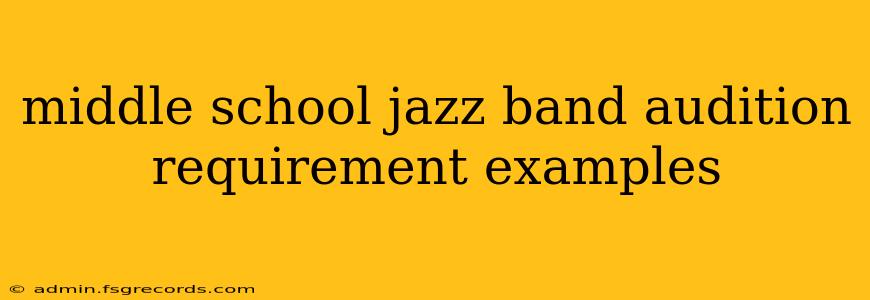Landing a spot in the middle school jazz band is a thrilling goal for many young musicians. The audition process can feel daunting, but with the right preparation, it can be a rewarding experience. This guide provides examples of common audition requirements and strategies to help aspiring jazz musicians succeed.
Common Audition Requirements for Middle School Jazz Bands
While specific requirements vary between schools and music programs, several elements consistently appear in middle school jazz band auditions. These usually include a combination of prepared pieces and sight-reading exercises, designed to assess a student's musical abilities and potential.
1. Prepared Solo Piece: Showing Your Musicality
This is often the most significant part of the audition. The piece should showcase your technical skills and musical expression. Here are some example requirements and suggestions:
-
Length: Typically, a piece lasting between 60 and 90 seconds is appropriate. Keep it concise and impactful.
-
Style: The style depends on your instrument. For example:
- Saxophone/Trumpet/Trombone: A bluesy ballad, a swing tune, or a bebop standard (simplified if needed). Think recognizable melodies that demonstrate control and phrasing.
- Guitar: A jazz standard, a blues riff, or an original composition demonstrating improvisation skills. Strong chord voicings are key.
- Piano: A jazz standard, a blues improvisation, or a piece showing proficiency in both melody and accompaniment. Comping skills are crucial.
- Bass: Walking bass lines, demonstrating strong rhythmic accuracy and understanding of harmonic progression. Simple but accurate walking bass is key.
- Drums: A steady beat with improvisation over a chord progression. Focus on time, feel, and dynamic control. A simple blues or swing feel is often ideal.
-
Difficulty: Choose a piece challenging enough to show off your abilities but not so difficult that you make mistakes due to nerves. Aim for a piece you can play confidently and expressively.
Example Prepared Pieces (Consult your teacher for appropriateness):
- "Take Five" (Dave Brubeck) - adapted for various instruments
- "Autumn Leaves" - a standard with many arrangements
- "Misty" - another classic with adaptable arrangements
- "C Jam Blues" - a fundamental blues in C
2. Sight-Reading: Demonstrating Musical Agility
Sight-reading evaluates your ability to interpret and play unfamiliar music. Expect a short excerpt of unfamiliar jazz notation.
- Focus: Accuracy and rhythm are critical. Don't worry about perfect intonation or expression; focus on playing the notes accurately and rhythmically.
- Practice: Regular sight-reading practice is essential. Utilize jazz method books or online resources offering sight-reading exercises.
3. Improvisation (Optional but Advantageous): Spontaneity and Creativity
Some middle school jazz band auditions may include an improvisation section. This tests your creative musicality and ability to respond to musical cues.
- Preparation: Familiarize yourself with basic jazz scales (major, minor, blues) and arpeggios. Practice improvising over simple chord progressions.
- Approach: Start simple, focusing on clear articulation and rhythmic accuracy. Let your personality shine through!
4. Technical Skills Assessment (Instrument Specific): Fundamental Proficiency
This part focuses on the fundamental techniques essential for your instrument:
- Brass: Range, articulation, intonation.
- Woodwinds: Tone quality, articulation, breath control.
- Strings: Bowing techniques, intonation, vibrato.
- Piano: Scales, chords, arpeggios.
- Guitar: Chords, scales, strumming patterns.
- Drums: Rudiments, time keeping, dynamics.
Tips for a Successful Audition
- Practice Regularly: Consistent practice is crucial for mastering your pieces and improving your sight-reading skills.
- Seek Feedback: Ask your teacher or a mentor to listen to your prepared piece and offer constructive criticism.
- Stay Calm: Manage your nerves by practicing in front of others and visualizing a successful audition.
- Dress Appropriately: Dress neatly and professionally to make a good impression.
- Be Prepared: Arrive early with all necessary materials (instrument, music, tuner).
- Be Polite and Respectful: Show courtesy to the audition panel.
By understanding the common audition requirements and following these tips, aspiring middle school jazz musicians can confidently prepare for their auditions and increase their chances of joining the band. Remember, the key is practice, preparation, and showcasing your musical passion!

